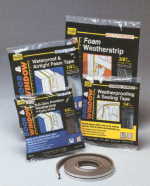Search engine visitors - click here to access entire "$ensible Home" web site
Click here to see a descriptive illustration showing how to weatherstrip a door yourself.
Dear Jim: During the winter, I feel drafts near the back and side doors. The doors are still in good shape, but they have gotten leaky from years of use. What is the best type of weatherstripping to seal them? - S. C.

A: Back and side door weatherstripping typically receives more wear and tear than on front doors, especially with children around. You should be able to weatherstrip the doors for about $25 in materials for an annual savings of up to $100 in energy costs.
If you air-condition in the summer, airtight doors have an even greater impact on your utility bills. Since the indoor-to-outdoor temperature differences are less, more of the energy losses are due to air leakage.
Before weatherstripping the doors, first make sure that they actually are leaky. Many times an uninsulated door can allow the room air near it to become cold and this can be mistaken as a chilly air leak. On a windy day, move a lighted candle or stick of incense around the door seal. You will quickly detect any leaky spots. On a calm day, switch on kitchen and bathroom exhaust fans to create a negative indoor pressure to simulate the wind forces.
The selection of the proper type of weatherstripping depends on your door and how often it is opened. For a seldom-used door, adhesive-backed foam weatherstripping is inexpensive and simple to install. With heavy usage, however, its airtight seal will not hold up long.
If the mating surfaces between your door and door jamb are not too warped or worn, using a spring metal V-strip is effective and durable. Since it is mounted in the door jamb, it is fairly well protected from damage from little feet and hands.
V-strip is available in rolls. Nail the longer leg of the "V" to the door frame with the "V" pointing in the direction the door opens. Bend out the free leg a little to form the "V". When the door closes, the free leg springs against the door edge to block air leaks.
Rolled tubular vinyl seals are also easy to install. Nail the backing strip on the bulb to the door jamb. The bulb should extend slightly past the edge of the door stop so it is compressed when the door is closed. One drawback to this type is that the bulb is exposed and susceptible to damage.
Interlocking metal strips are the best sealing type, but most difficult to install. One strip is mounted on the edge of the door and the mating strip is mounted on the door jamb. It is also well protected from possible damage.
Instant Download Update Bulletin No. 410 - do-it-yourself instructions with illustrations for sealing and weatherstripping doors and windows, types and descriptions of various types of door bottom weatherstripping available (illustration of each type) and a chart of caulking materials.
Dear Jim: Our house has some of the heating and cooling ducts running through the attic and some through the crawl space. Is it important to insulate the ducts and how much insulation is recommended? - R. J.
A: It is important to insulate ducts that run through unconditioned attics and crawl spaces. Attic ducts should have a minimum of R-8 insulation and crawl space and basement ducts require R-4. Use R-11 in very cold climates.
Also tape all the duct joints you can find. Some tests show that sealing small leaks in ducts can save four times as much energy as insulating ducts. There is not much you can do to seal ones hidden inside the walls.